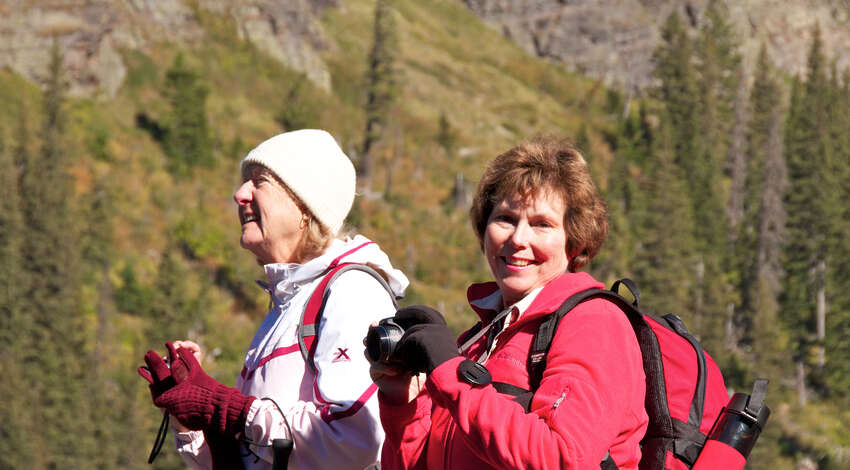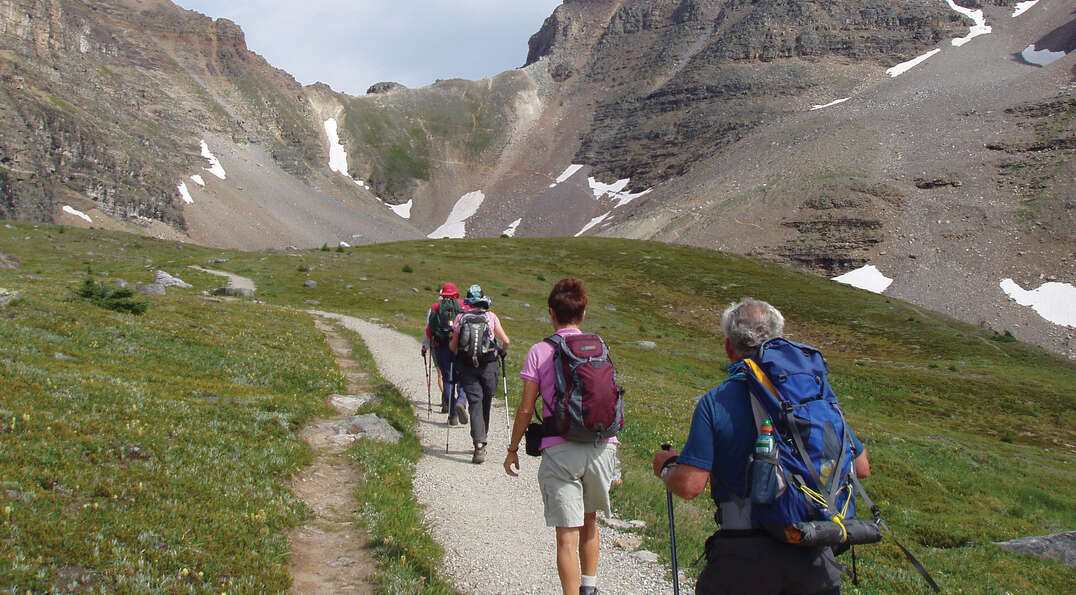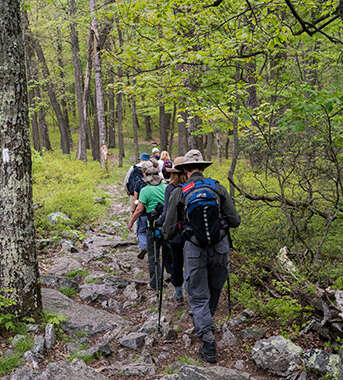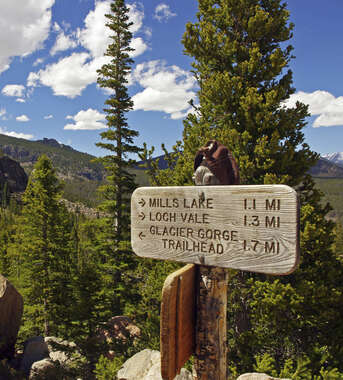Leave No Trace and Trail Etiquette: The Hiker’s Checklist
- Leave No Trace principles protect nature and ensure trails remain as intended for future generations.
- Practicing trail etiquette creates a safer, friendlier experience for all trail users, such as walkers, bikers and horseback riders.
- Always pack out what you pack in, even small items like tissues or wrappers.
- Maintain a safe distance from wildlife and stay strictly on marked trails to help prevent erosion and protect delicate plants.
- Follow right-of-way rules: Yield to horses and to hikers coming uphill.
- Keep noise to a minimum to avoid disturbing wildlife and always keep pets leashed unless otherwise permitted.
- Adhere to fire safety rules, respect what you find in nature, share rest areas and viewpoints and keep group sizes small.

There’s something deeply rewarding and timeless about stepping onto a trail. If you find yourself on a mountain path or forested trail, you can take some time to pause, reflect and breathe in the fragrance of pine or desert sage, all while feeling the leaves crunch beneath your feet. For many, the joy of hiking deepens with age, as each adventure offers an opportunity to slow down and connect with nature.
Yet with this privilege comes responsibility. Whether you’re setting out on a gentle woodland path or a bucket-list trek through a national park, following Leave No Trace principles and practicing good trail etiquette helps ensure these natural landscapes remain unspoiled for the next explorer.
Being mindful on the trail not only helps preserve the beauty that surrounds us but also creates a safer, more enjoyable experience for every hiker. From courteously sharing the path with others to minimizing your impact on the environment through responsible hiking etiquette practices, simple habits help keep the great outdoors welcoming and wild, just as it should be.
Why Trail Etiquette Matters
Hitting the trail offers more than fresh air and exercise. It’s also about sharing space, protecting the land and respecting the experiences of others who come after you. Following established hiking rules and trail etiquette helps keep the outdoors inviting for hikers, bikers and wildlife alike. Here’s why hiker etiquette matters:
-
Preserves nature: Leaving no trace and staying on designated trails minimizes damage to plants, wildlife and fragile ecosystems.
-
Keeps trails safe: By following hiking trail etiquette, you help reduce the risk of accidents and conflicts between hikers, bikers and other trail users.
-
Prevents trail erosion: Staying on designated paths helps protect the land from long-term wear and tear.
-
Supports wildlife health: Proper trail etiquette avoids disturbing animals and keeps them from becoming dependent on humans.
The Hiker’s Trail Etiquette Checklist
From hiking trips in national parks to international walking and hiking adventures, understanding trail etiquette is essential to protecting nature and ensuring everyone’s safety. Keeping these hiking rules and trail etiquette tips in mind before heading out on your next excursion will help make for a safer, more enjoyable experience for you and other hikers, while preserving the natural environment.
Pack In, Pack Out (Leave No Trash Behind)
Everything you bring — from water bottles and snack wrappers to tissues and clothing — should leave with you. Packing out what you pack in is one of the most important hiking etiquette tips. These simple practices help ensure a clear passage free from debris for all hikers to enjoy. You might even consider bringing a small bag to collect any litter you might come across on your trek, as even small items left behind can harm wildlife or spoil the scenery for others.
Stay on Marked Trails
When it comes to hiker etiquette, it’s crucial to hike only on marked trails. Staying on designated paths protects delicate plant life and limits erosion, as trails are purposefully designed to balance access with conservation. While it might be tempting to cut corners or wander off trail, staying the course maintains the health of the landscape.
Yielding the Right of Way
Knowing when to step aside makes the trail safer and friendlier. Typically, proper hiking etiquette requires hikers to yield to horses, and for hikers going downhill to yield to hikers going uphill. A smile and a friendly “hello” go a long way in creating a positive experience for everyone.
Keep Noise Levels Down
Part of the joy of hiking is the peace and quiet that nature offers. Loud sounds, music or phones disrupt that serenity for others and can startle wildlife. It’s best to keep conversations soft and leave speakers at home so everyone can enjoy the sights and natural sounds of the outdoors.
Control Pets Properly
Dogs can be great trail companions, but they, too, should follow proper trail etiquette. Keep pets leashed unless the area allows otherwise, and always clean up after them. This keeps wildlife safe and ensures fellow hikers feel comfortable on the trail.
Respect Wildlife
Wild animals belong in their natural environments. During your hiking trips and walking adventures, observe wildlife from a distance, never feed them and avoid sudden movements. Respecting animals protects their well-being and keeps you safe. If you encounter a wild animal, remain calm and prepare for defensive steps. Back away slowly to give them space, and never approach or pursue them. Packing bear spray and a whistle or air horn to make noise can offer extra protection.
Be Mindful of Group Size
Hiking with friends or family is wonderful and adds to the hiking experience, but large groups can overwhelm narrow trails and disturb others. Before planning international or North American hiking adventures, consider going with a smaller group or breaking into smaller groups to maintain a pleasant atmosphere for everyone.
Trail Courtesy at Rest Areas and Viewpoints
When you reach rest areas or viewpoints, keep in mind that these are shared spaces. Be mindful not to linger too long in the prime viewing spots or block pathways with bulky gear that can make it difficult for other hikers to pass. A little awareness makes it easier for everyone to enjoy the same breathtaking views.
Follow Fire Safety Rules
Campfires can be inviting, but they’re also one of the leading causes of wildfires. Always check regulations and trail conditions, use designated fire rings if permitted and make sure flames and embers are completely out before leaving. When in doubt, opt for a camp stove instead.
Leave What You Find
Nature’s beauty is undeniable, and taking home natural souvenirs like stones, flowers or artifacts may be tempting, but leaving nature as it is ensures others can enjoy it too. Take photos instead of souvenirs to capture memories in a more respectful way while preserving nature’s beauty for future generations.

Hiking group
Ready to Hit the Trail? Hike Responsibly and Leave No Trace
With these trail etiquette tips in mind and by treating nature with respect, you help preserve the beauty and peace that drew you there in the first place. Good hiking etiquette makes the journey safer, more enjoyable and deeply rewarding, and, after all, the trails we walk today are the ones we hope to leave for the next generation of explorers




